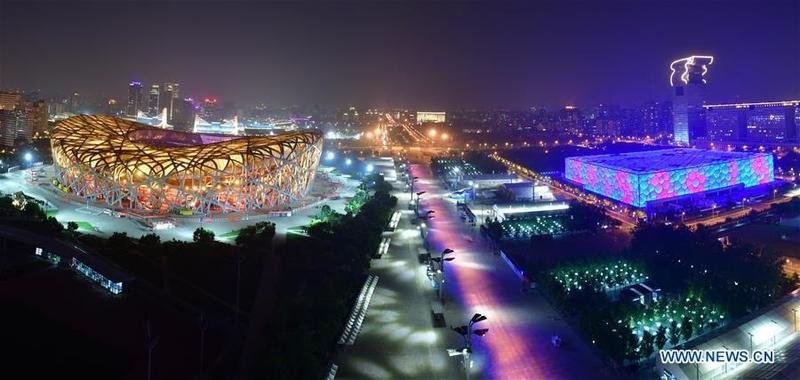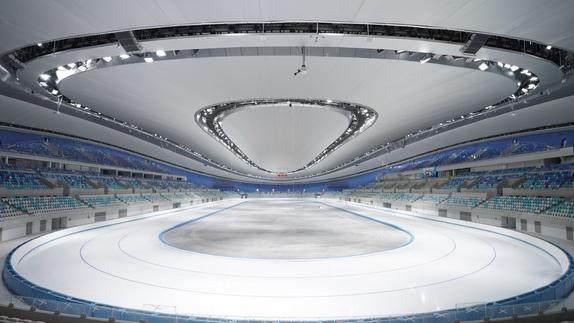 This photo taken on May 14, 2019 shows the night view of the National Stadium, also known as the Bird's Nest, and the National Swimming Center, also known as the Water Cube, in Beijing, capital of China. (PHOTO / XINHUA)
This photo taken on May 14, 2019 shows the night view of the National Stadium, also known as the Bird's Nest, and the National Swimming Center, also known as the Water Cube, in Beijing, capital of China. (PHOTO / XINHUA)
Beijing is fulfilling its promise to host a sustainable Winter Olympics in 2022 with a number of Summer Olympic sites repurposed and eco-friendly technologies applied.
According to the organizing committee, all venues for the Beijing 2022, comprising newly built or renovated ones, have been completed so far and a series of trial events are being staged in the three competition zones-downtown Beijing, the city's northwestern district of Yanqing and the co-host city, Zhangjiakou, Hebei province.
The downtown area, which has 13 venues for competitive and noncompetitive events, reused 10 sites built for the 2008 Summer Olympics.
The National Stadium, also known as the Bird's Nest, finished renovations last month and will host the opening and closing ceremonies for the 2022 Winter Olympics
For example, the National Stadium, also known as the Bird's Nest, finished renovations last month and will host the opening and closing ceremonies for the 2022 Winter Olympics.
At the National Indoor Stadium, one of the three major venues for the Beijing 2008, the temperature-control and lighting systems have been upgraded to stage hockey events.
Also, the National Aquatics Center, which was constructed for the swimming and diving events in 2008, has been transformed into the Ice Cube for curling events in 2022.
The yearlong restoration project included filling the main pool with removable steel structures and making ice sheets cover the pool, according to organizers.
Since 2019, the venue has completed the water-to-ice conversion three different times and hosted an array of test events.
The tacks were Olympic-level, and the removable structure was such a sophisticated facility that it can perfectly bolster the ice surface, said experts from the World Curling Federation.
Yang Qiyong, general manager of the venue, said the stadium can be switched for different sports in summer or winter, making it a remarkable example for sustainable development.
In addition to venues, four pieces of land as legacies of the 2008 Summer Olympics were also reused for the 2022 Games.
 This file photo taken on Jan 22, 2021 shows the interior view of the National Speed Skating Oval in Beijing, which has finished ice-making trials. (JU HUANZONG / XINHUA)
This file photo taken on Jan 22, 2021 shows the interior view of the National Speed Skating Oval in Beijing, which has finished ice-making trials. (JU HUANZONG / XINHUA)
Built on the land for two temporary Summer Olympic venues, the National Speed Skating Oval is the first Olympic venue in the world to utilize carbon dioxide instead of the harmful substance Freon as a refrigerant for the 12,000-square-meter ice sheet, the largest of its kind in Asia
ALSO READ: Technology goes for gold at Winter Olympics
Built on the land for two temporary Summer Olympic venues, the National Speed Skating Oval is the first Olympic venue in the world to utilize carbon dioxide instead of the harmful substance Freon as a refrigerant for the 12,000-square-meter ice sheet, the largest of its kind in Asia.
The green cooling technique helps reduce the ice's temperature difference and maintain its density and firmness, allowing skaters to push their limits, a venue operator said.
Compared with the old system, the new one is estimated to save 2 million kilowatt-hours of electricity annually, he added.
Liu Xinping, director of sustainability of the Beijing 2022 organizing committee's general planning department, said: "The concept of sustainability has been embedded in the entire construction process of Olympic venues."
Reusing sites reflects China's efforts to meet the International Olympic Committee's reform agenda, which is aimed at making future Games more cost-effective, intelligent and green, Liu added.
After the Games, the National Speed Skating Oval is set to become a sports and entertainment center for the public.
READ MORE: Volunteers ready for Beijing 2022
Ma Jin, design director of the ice-making project, told Xinhua that the ice in the oval adopts a submodule control unit, which can divide the giant ice sheet into a number of smaller rinks and make ice for different sports such as hockey, curling and figure skating.
This design will support the venue's post-games utilization and meet local residents' varying needs for ice sports, Ma said. Similarly, the Wukesong Sports Center features an ice surface that can change size to stage ice hockey, figure skating and short-track speed skating competitions after the Olympics.


